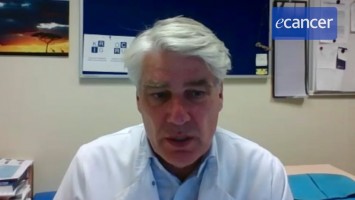WIN 2012, June 28-29, Paris, France
Vandetanib increases progression free survival in medullary thyroid carcinoma
Dr Nick Botwood – AstraZeneca, UK
So, Vandetanib, originally used in lung cancer, we heard you present some very interesting data now it’s being used as a targeted agent in medullary thyroid cancer.
Yes, that’s right. Vandetanib was originally developed on the basis that it had activity against vascular epithelial growth factor and also endothelial growth factor. So it was inhibited as a dual inhibitor of those two targets which was thought to have therapeutic benefit in non-small cell lung cancer. So AstraZeneca took forward a large development programme in combination with chemotherapy and also as a stand-alone therapy in non-small cell lung cancer. Unfortunately, however, in unselected patients, so in the whole population of patients with lung cancer, the drug didn’t demonstrate sufficient benefit to be approved and to be available to patients in that indication. However, as I spoke about today, the drug also has activity against the RET oncogene and some data we generated demonstrating that it has activity, therefore, for patients with medullary thyroid carcinoma, which is a subset of thyroid carcinoma where the RET oncogene plays an important part. So, on the basis of some encouraging phase II data that showed response rates, we undertook a phase III programme in about 300 patients comparing vandetinib against no therapy or standard best supportive care therapy in a large randomised controlled trial. Those data showed that the drug produced significant improvement in overall response rate which was meaningful and durable and this translated into a meaningful delay also in patients’ progression free survival. On the basis of those data the drug was given approvals for use in the United States and also, more recently, in Canada and in Europe for patients that have advanced medullary thyroid carcinoma with either aggressive or progressive disease or patients who have symptoms from their disease.
So what happened? How did you discover that the drug was active against the RET oncogene?
This was from some pre-clinical data that was generated that showed that the drug actually had activity against RET. It’s known that the RET oncogene plays an important part in medullary thyroid carcinoma and potentially other tumour types as well. Some recent publications from earlier this year suggest that the RET translocation may be important also in non-small cell lung cancer and that’s an area that we would like to explore further in clinical trials in that setting. It’s a relatively rare mutation in non-small cell lung cancer, the literature suggests it’s somewhere between 1-2% up to maybe 4-5%. So clearly to find that abnormality a number of patients would need to be screened. But it’s very much the direction in which cancer care is going in that these highly targeted drugs are likely to be of most benefit in very, very highly selected patients that exhibit the target which the drug is developed to inhibit.
And is this affecting the way that AstraZeneca works for drug development?
Yes, absolutely. I think this underpins certainly the development strategy for AstraZeneca and I think all pharma and academia that increasingly as we understand the molecular gene typing of tumours that we will increasingly get a segmented approach to both the diagnosis and the treatment of cancer in the future. And there are already, indeed, many precedents of that in clinical practice.
And we’re here at WIN and we’re hearing a lot about the relationship between pharma and academia. Are you actually working at all with academic institutions?
Yes, absolutely. This is fundamentally important, in order for us to be successful in this battle against cancer we have to collaborate, certainly with academia but also with PAILS, with patient advocacy and, of course, with health authorities. That’s something that we’re actively doing and the RET oncogene example that I was just talking about is a very good example of the importance of that collaboration because, clearly, in small subsets of patients where the drug may have activity, screening a large number of patients is going to require a very, very close collaboration with the academic and the clinical community across pharma and also with health authorities because it’s likely that it will only be possible to treat a relatively small number of patients in order to be able to demonstrate the efficacy because it’s a relatively rare mutation in that particular tumour type.
OK, thank you.








